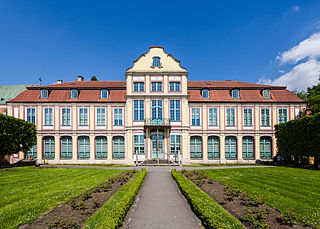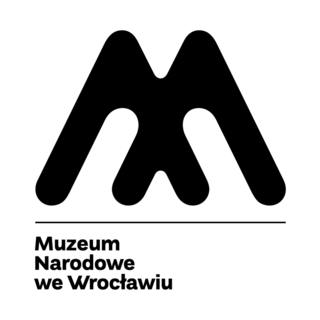
The Foksal Gallery or Galeria Foksal is a non-commercial gallery space in Warsaw, Poland established in 1966, that shows works by contemporary avant-garde artists.

The Foksal Gallery or Galeria Foksal is a non-commercial gallery space in Warsaw, Poland established in 1966, that shows works by contemporary avant-garde artists.
The Foksal Gallery was founded in 1966 by a group of Polish art critics and artists, which included one of the founder members of the Polish Constructivist Group of the 1920s. [1] From the outset the gallery's activities were underpinned by the strong philosophical basis embodied within the essay "Wprowadzenie do ogolnej Teorii Miejsca (Introduction to the general Theory of Place)" (1966). The critics associated with the Foksal Gallery; Anka Ptaszkowska, Mariusz Tchorek, Wiesław Borowski established the gallery as a "place, a sudden gap in the utilitarian way of world comprehension", in which art could exist without reference to context or history, a place exempt from outside rules or influence. [2] They also proposed that the venue, "as the most authentic theme of the event", was now to become the actual subject. In addition to the aforementioned critics, the artist-founders at the Foksal included Tadeusz Kantor, Roman Owidzkiego, Edward Krasinski (whose signature blue Scotch tape intervention still winds its way through the gallery's ancillary spaces), [3] Zbigniew Gostomski [4] and Henryk Stażewski. [1]
Zbigniew Gostomski (b. 1932), a founder artist of the Foksal Gallery, held the inaugural exhibition on 1 April 1966 showing works of his Optical Objects series. [4] Tadeusz Kantor and Wlodzimierz Borowski were involved in actions at the gallery during the 60's. The Foksal succeeded in showing work of an avant-garde nature throughout the communist era, apart from a short period of martial law, during which it was 'closed for renovation'. [5] For its first twenty years the Foksal Gallery functioned within the state controlled system, nonetheless succeeding in developing an internationally significant programme of contemporary art under the Directorship of Wieslaw Borowski in co-operation with Andrzej Turowski. Milada Ślizińska also curated a series of exhibitions. Jaromir Jedlinski (previously of the Museum Sztuki in Łódź), was the gallery's Director from July 2006 until August 2008. Nowadays the gallery is run by the younger generation of curators: Katarzyna Krysiak (Artistic Director/Head Curator), Lech Stangret and Monika Weychert Waluszko.
The gallery acted under the auspices of the Laboratory of Arts Plastycznych (PSP) until 1982, then under SBWA until 2001. At present, it remains government funded under the Mazovia Region Centre For Culture and Art (MCKiS).
The Foksal Gallery has for many years been one of the most influential art galleries in Poland, with shows by many internationally acclaimed artists including Christian Boltanski, Henryk Stażewski, Joseph Beuys, Royden Rabinowitch, Anselm Kiefer, Luc Tuymans, Bill Viola, Tadeusz Kantor, Ian Hamilton Finlay, Koji Kamoji, Leon Tarasewicz, Douglas Gordon, Matthew Barney, Marek Chlanda and Victor Burgin among many other notable names.
In 1997 the Foksal Gallery Foundation was formed to widen the scope of activities of the gallery. Initially based within the Foksal Gallery, the Foksal Gallery Foundation moved out in 2001 and now operates, somewhat controversially (because of the historic "Foksal" brand usage among others), as an independent and commercial entity, that has nothing to do with the Foksal Gallery activities whatsoever.[ citation needed ]
The gallery is named after Foksal, the name of the street at the end of which it can be found. 'Foksal' is said to be a Polish corruption of 'Vauxhall' the name given to the street when the Foksal park area was created in the nineteenth century by a merchant who had been inspired by the atmosphere of London's Vauxhall Pleasure Gardens in Vauxhall.
Artists shown at the gallery include:

The Polish Mathematical Society is the main professional society of Polish mathematicians and represents Polish mathematics within the European Mathematical Society (EMS) and the International Mathematical Union (IMU).

Henryk Stażewski was a Polish painter, visual artist and writer. His career spanned seven decades and he is considered a pivotal figure in the history of constructivism and geometric abstraction in Poland. Stażewski was one of the few prominent Polish avant-garde artists of the interwar period who remained active and gained further international recognition in the second half of the 20th century.

The Zachęta National Gallery of Art is a contemporary art museum in the center of Warsaw, Poland. The Gallery's chief purpose is to present and support Polish contemporary art and artists. With numerous temporary exhibitions of well-known foreign artists, the gallery has also established itself internationally.

Ujazdów Castle is a castle in the historic Ujazdów district, between Ujazdów Park and the Royal Baths Park, in Warsaw, Poland.

Silesian Museum in Katowice is a museum in the City of Katowice, Poland.

The National Museum in Kraków, popularly abbreviated as MNK, is the largest museum in Poland, and the main branch of Poland's National Museum, which has several independent branches with permanent collections around the country. Established in 1879, the museum consists of 21 departments which are divided by art period: 11 galleries, 2 libraries, and 12 conservation workshops. It holds some 780,000 art objects, spanning from classical archeology to modern art, with special focus on Polish painting.

The Abbots' Palace in Oliwa is a rococo palace in Oliwa, a quarter of Gdańsk. It houses the Department of Modern Art of the National Museum in Gdańsk, and along with the Cistercian-Cathedral complex in Oliwa it is listed as a Historic Monument of Poland.

The National Museum in Wrocław, established 28 March 1947 and officially inaugurated on 11 July 1948, is one of Poland's main branches of the National Museum system. It holds one of the largest collections of contemporary art in the country.

Art in Poland refers to all forms of visual art in or associated with Poland.

Muzeum Sztuki, or the Museum of Art in Łódź, is a museum of modern and contemporary art in Łódź, Poland, whose main goal is to research and display the history of avant-garde art, with a focus on Central and Eastern Europe. Founded in 1931, Muzeum Sztuki is one of oldest institutions in the world dedicated to collecting modern art still in existence.

Ryszard Henryk Grzyb, a Polish painter, poet, and graphic designer.

Maria Jarema was a Polish painter, sculptor, scenographer and actress.

Biennale of Spatial Forms in Elbląg was a bi-annual art exhibition organized by state-owned Zakłady Mechaniczne Zamech in Elbląg between 1965 and 1973. Described as the largest "experiment combining art and industry in Poland," the biennale had five editions, with only the first two dedicated primarily to sculpture and spatial forms.